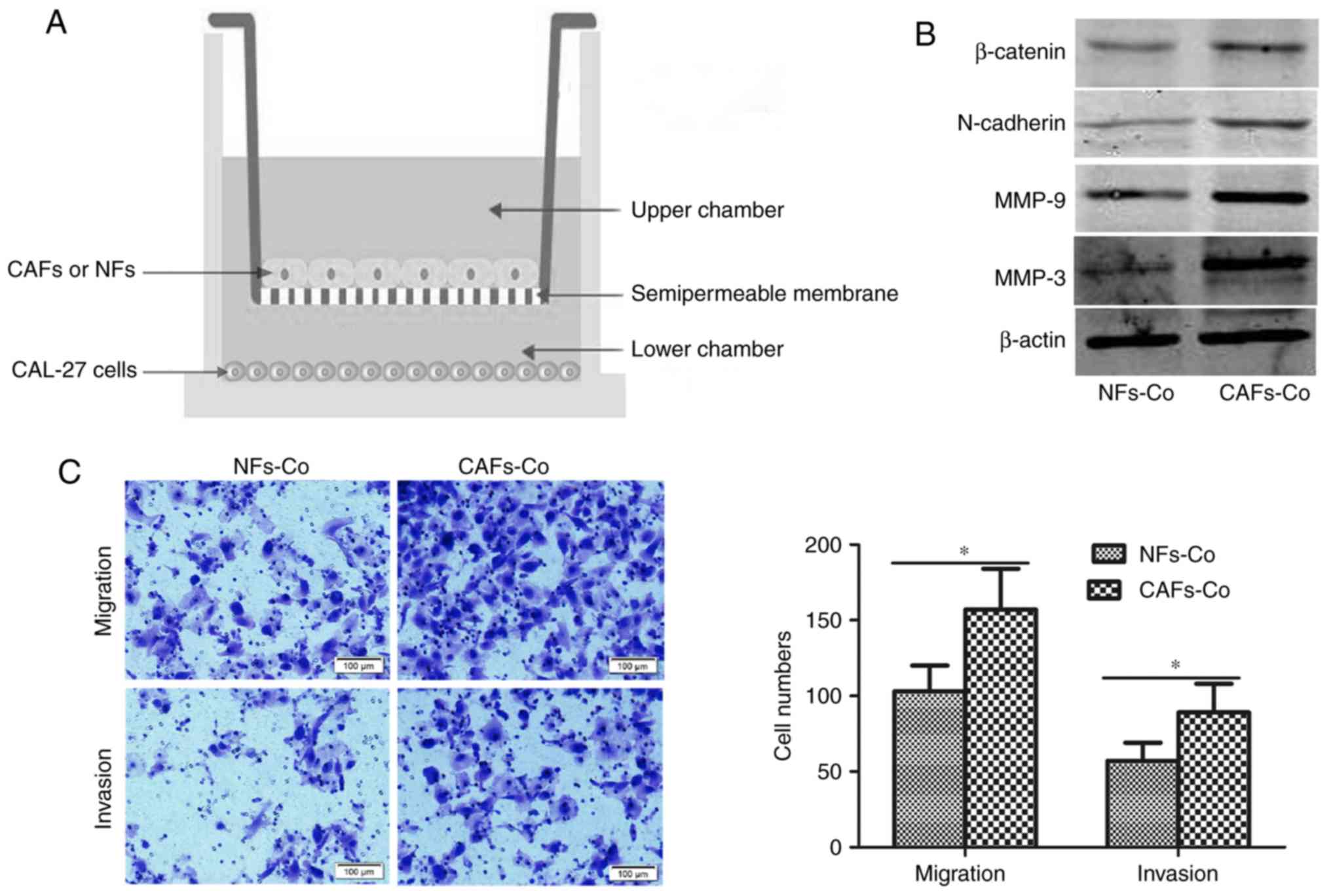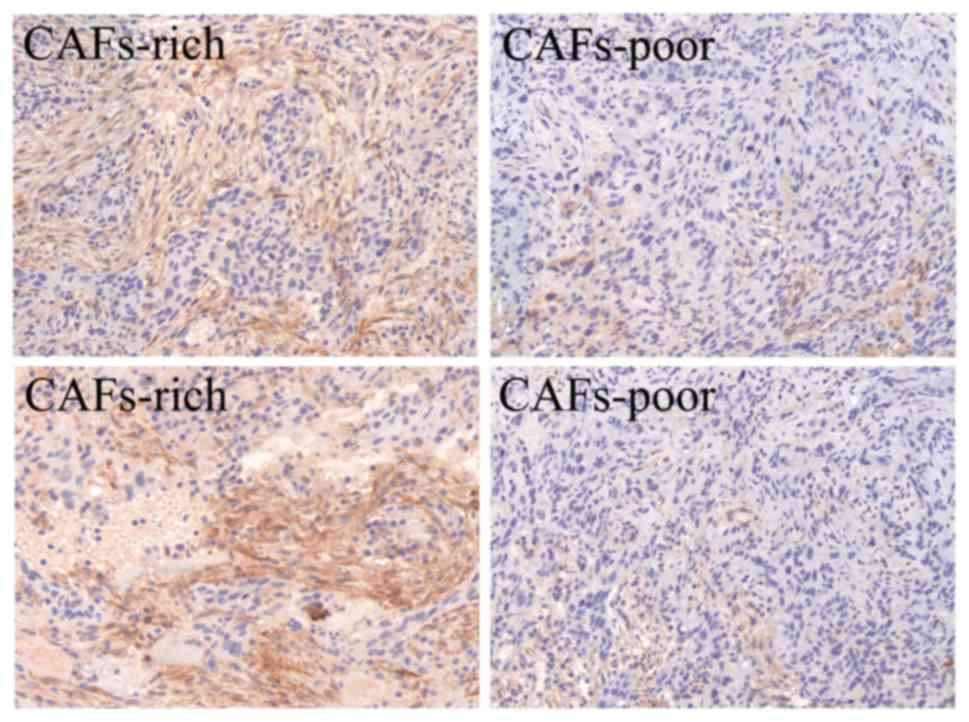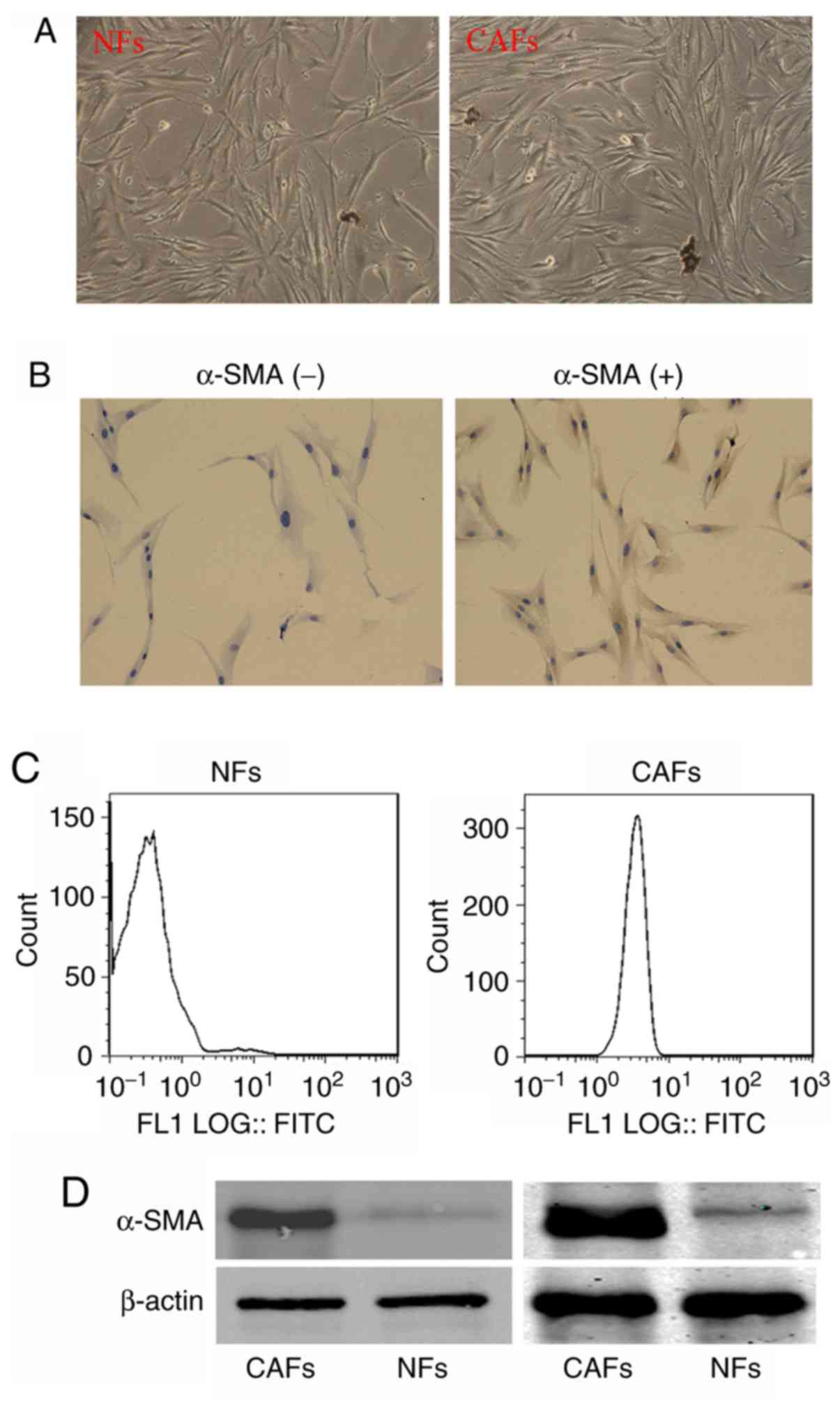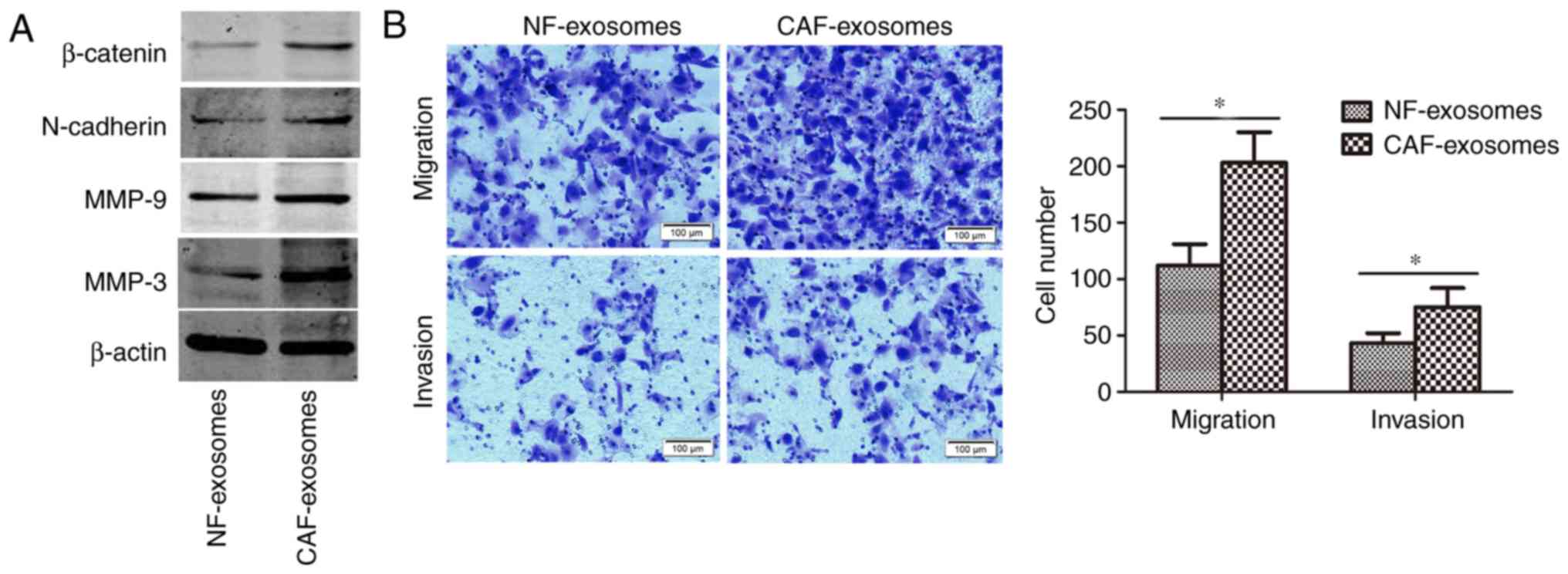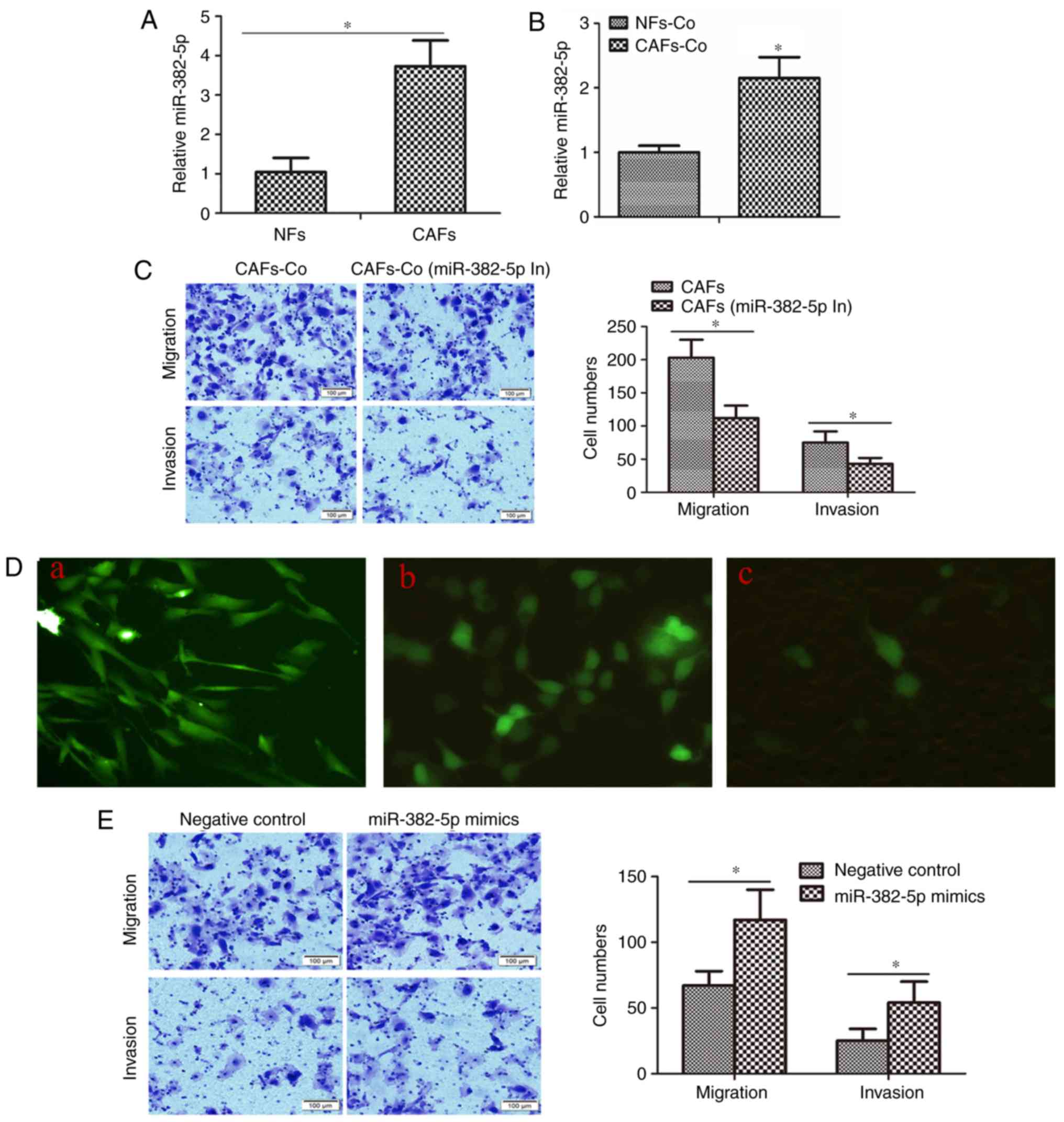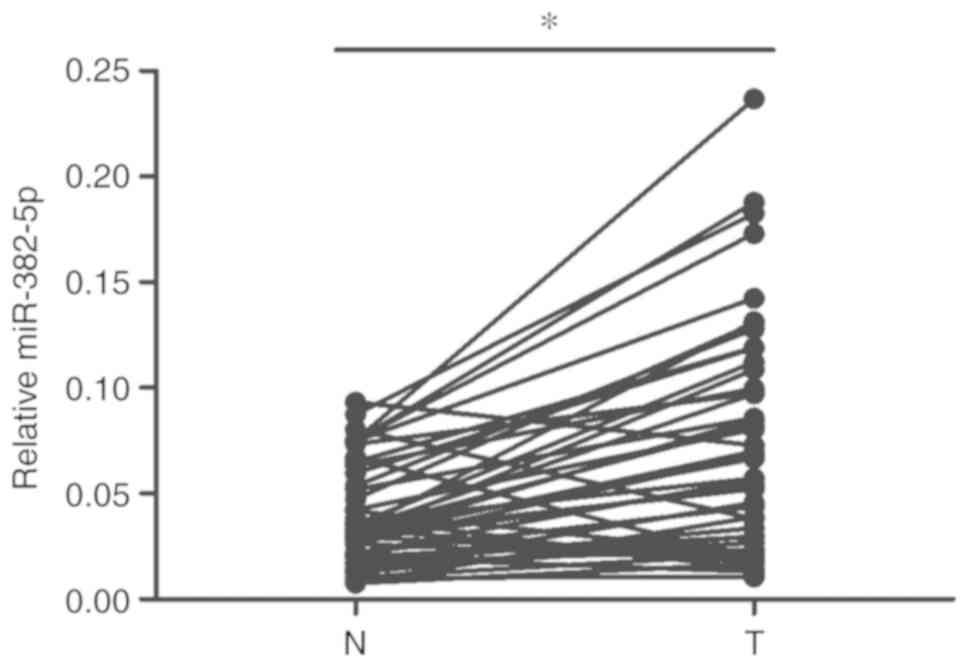Cancer‑associated fibroblast‑derived exosomal miR‑382‑5p promotes the migration and invasion of oral squamous cell carcinoma
- Authors:
- Published online on: July 30, 2019 https://doi.org/10.3892/or.2019.7255
- Pages: 1319-1328
-
Copyright: © Sun et al. This is an open access article distributed under the terms of Creative Commons Attribution License.
Abstract
Introduction
Oral squamous cell carcinoma (OSCC) is the most common malignant tumor of the head and neck (1). Elucidation of the mechanisms related to OSCC development and progression could provide candidate diagnostic biomarkers and promising therapeutic targets for OSCC. Previous studies have mainly focused on the tumor cell itself, as several gene alterations have been demonstrated to be associated with OSCC development and progression, such as inactivation of p53 (2), Notch mutation (3) and loss of NDRG2 expression (4). Actually, not tumor cells but the tumor microenvironment is associated with tumor metastasis (5,6). However, the mechanism of the tumor microenvironment in promoting OSCC progression still remains not fully understood.
Cancer-associated fibroblasts (CAFs) are the main stromal cells in the microenvironment and are distinguishable from other cells by their spindle-shape morphology and expression of α-smooth muscle actin (α-SMA) (7). As abnormally reactive fibroblasts, CAFs play essential roles in several processes of cancer biology including tumor growth, tumor metastasis and drug resistance (8). Furthermore, CAFs are often considered to be associated with high-grade malignancies and poor prognosis (9,10), and therefore are suggested to be a prognostic biomarker. CAFs promote tumor progression mainly through actively communicating with cancer cells (11–13), and other cells in the tumor environment, including immunocytes (14) and vascular endothelial cells (15). The communications between CAFs and other cells are often mediated by several growth factors, hormones and cytokines (16,17). Actually, CAFs also modify the tumor environment by transferring molecules to other cells by secreting exosomes (18).
Exosomes are nano-sized vesicles (~30–150 nm) secreted by cells (19,20), and serve as mediators of cell-to-cell communication. They play important roles in many cell processes, including tumor growth, invasion, metastasis and chemoresistance (21–23). Exosomes deliver a great variety of bioactive molecules including signal peptides, microRNAs, lipids and DNA, from cell to cell (24). MicroRNAs, a major class of small non-coding RNAs that mediate post-transcriptional gene silencing of target mRNAs and participate in various physiological and pathological processes (25), are highly enriched in exosomes and are delivered from one cell to neighboring or distant cells (26). Compared with normal fibroblasts, one characteristic of abnormally inactive CAFs is the dysregulation of miRNAs, which leads to the re-modification of the tumor microenvironment and correspondingly induces drug resistance, cell migration and invasion, and tumor growth (18). Therefore, using miRNAs or miRNA inhibitors to restitute the abnormal expression of miRNAs in CAFs may be ‘a way out’ for tumor therapy.
miR-382-5p is a primary miRNA species of miR-382 and functions as an onco-miRNA in several tumors, including breast cancer (27), liver cancer (28), acute promyelocytic leukemia (29) and glioma (30). By regulating target gene expression, miR-382-5p plays important roles in tumor progression. miR-382-5p was found to target circ-DICER1 and correspondingly regulate angiogenesis in glioma (30). In liver cancer, miR-382-5p was reported to promote tumor metastasis by efficiently suppressing DLC-1 expression (28). Bhome et al detected the distinguishable miRNAs in CAFs and normal fibroblasts (NFs), and the expression of several miRNAs, including miR-382-5p, was significantly higher in CAFs than in NFs (31). In OSCC, it has been reported that a newly identified circRNA, hsa-circ-0008309, could sponge miR-382-5p and regulate ATXN1 expression (32); however, the function of miR-382-5p in OSCC migration and invasion remains unknown.
In the present study, the role of CAFs in mediating OSCC cell migration and invasion was investigated, and the participation of exosomal miR-382-5p in this process was elucidated.
Materials and methods
Patients and tissue samples
Forty-seven OSCC patients, 27 male and 20 females, ranged from 39 to 72 years old, who underwent tumor resection at the Department of Oral Maxillofacial Surgery of Liaocheng People's Hospital from 1 January 2014 to 31 December 2017 were enrolled in this study. Patient, clinical and pathologic characteristics were retrieved from the Medical Records Room. All patients signed informed consent prior to participating in this study, and this study was approved by the Ethics Committee of Shandong University (Shandong, China).
Antibodies and reagents
Anti-α-SMA (cat. no. 19245), anti-MMP-3 (cat. no. 14351), anti-MMP-9 (cat. no. 13667), anti-β-catenin (cat. no. 8480) and anti-N-cadherin (cat. no. 13116) were purchased from Cell Signaling Technology, Inc. (Danvers, MA, USA), and anti-β-actin (SC-70319) was purchased from Santa Cruz Biotechnology, Inc. (Dallas, TX, USA). GW4869 was purchased from Selleck Chemicals (Houston, TX, USA).
Cell culture
Tongue squamous cell carcinoma CAL-27 cells were purchased from the American Type Culture Collection (ATCC; Manassas, VA, USA) and incubated in Gibco DMEM (Thermo Fisher Scientific, Inc.) with 10% fetal bovine serum (FBS) (Thermo Fisher Scientific, Inc.) at 37°C in a 5% CO2 incubator.
Isolation of fibroblasts
Fibroblasts were isolated according to a previous study (33). Briefly, fibroblasts were isolated from freshly resected OSCC tissue and adjacent normal tissue from the OSCC patients treated at the Department of Stomatology, Liaocheng People's Hospital. The adjacent normal tissues were excised at least >3 cm distant from the margin of the tumor, and were verified by two senior pathologists. Tissues were minced into small pieces of about 1 mm3 and seeded onto 10-cm dishes in DMEM with 10% FBS at 37°C in a 5% CO2 incubator. Approximately 10 days later, homogeneous groups of fibroblasts formatted around the pieces in the dishes. The fibroblasts were passaged for more than 10 times and were then used for subsequent experiments.
Co-culture of the OSCC cells with CAFs or NFs
To elucidate the biological function of CAFs in OSCC metastasis, we employed a co-culture system (Corning Inc., Corning, NY, USA) (Fig. 3A). Briefly, CAFs or NFs were seeded in the upper chamber of the system, and the OSCC cells in the lower chamber. The upper chamber and lower chamber were separated with a semipermeable membrane with pores ~0.4-µm, which allowed the passage of exosomes and cytokines but prevented the shuttle of cells.
Immunohistochemistry (IHC)
OSCC tissue samples were first formalin-fixed and paraffin-embedded, and then dewaxed in xylene, rehydrated with gradient ethanol and treated in 0.01 mM citrate buffer (pH 6.0) for antigen retrieval. Then samples were stained with rabbit anti-α-SMA monoclonal antibody at 4°C overnight, followed by incubation in secondary biotinylated anti-rabbit antibody for 30 min at 37°C, and finally visualized with DAB solution and counterstained with haematoxylin. Based on the density of the CAF staining, the 47 OSCC patients were divided into two groups according to the standard reported in a previous study (34). Dense overlapping of CAFs distributed throughout the tumor were grouped as CAFs-rich, correspondingly, CAFs not distributed throughout the entire tumor were grouped as CAFs-poor (Fig. 1). Each stained sample was evaluated by two senior pathologists unaware of the clinical information, with conflicting cases adjudicated by a third pathologist.
Immunocytochemistry
Fibroblasts were fixed at room temperature for 10 min in 4% paraformaldehyde, and then cells were permeabilized in 0.5% Triton X-100 followed by a 15-min block in 5% normal goat serum (ZSGB-BIO, Beijing, China). The cells were then incubated with α-SMA antibody overnight at 4°C. Then the cells were washed three times in PBS and further incubated with s secondary biotinylated anti-rabbit antibody for 30 min at room temperature. Cells were observed under a light microscope at ×400 magnification (Nikon, Tokyo, Japan).
Exosome extraction
Exosomes were isolated from conditioned media collected from CAFs using a Hieff™ Quick Exosome Isolation Kit (for Cell Culture Media) (Yeasen, Shanghai, China) according to the manufacturer's instructions. Briefly, the conditioned medium was firstly cleared of cellular debris and the dead cells with two sequential centrifugation steps at 2,500 × g for 10 min at 4°C. Then 10 ml conditioned medium was collected into a centrifuge tube and 2.5 ml extraction reagent was added, followed by mixing and a 2 h of standing. After that, the conditioned medium was centrifuged at 10,000 × g at 4°C for 1 h. The precipitates were collected and re-suspended in 100 µl PBS buffer. After re-suspension, the solution was transferred into an EP tube and centrifuged at 12,000 × g at 4°C for 2 min. Finally, the supernatant containing the exosomes was collected.
Western blot analysis
Cells were lysed with RIPA lysis buffer (Applygen, Beijing, China). Protein concentrations were detected using the BCA Protein Quantitation kit (Thermo Fisher Scientific, Inc.). Thirty microliters of proteins were subjected to 10% sodium dodecyl sulfate (SDS)-polyacrylamide gel electrophoresis (PAGE) and transferred onto a nitrocellulose membrane (EMD Millipore, Billerica MA, USA). The membrane was blocked with 5% goat serum in TBS-T for 1 h, and then was incubated with primary antibodies diluted 1:1,000 in TBS-T containing 1% goat serum overnight at 4°C. Subsequently, the membrane was washed three times in TBS-T and then incubated with a HRP-conjugated secondary antibody for 1 h at room temperature. Finally, the membrane was visualized with Enhanced Chemiluminescence Plus reagents (Thermo Fisher Scientific, Inc.).
Transfection
miR-382-5p mimics, negative control (miR-NC), miR-382-5p inhibitor and negative control for miR-382-5p inhibitor were purchased from Shanghai GenePharma Co., Ltd. (Shanghai, China). The sequences are listed as follows: miR-382-5p mimics: Forward, 5′-GAAGUUGUUCGUGGUGGAUUGG-3′ and reverse, 5′-AAUCCACCACGAACAACUUCUU-3′; miR-NC: Forward, 5′-CTCGCTTCGGCAGCACA-3′ and reverse, 5′-AACGCTTCACGAATTTGCGT-3′; miR-382-5p inhibitor, 5′-CGAAUCCACCACGAACAACUUC-3′; negative control for inhibitor, 5′-CAGUACUUUUGUGUAGUACAA-3′. Transfection was performed using Lipofectamine 2000 reagent (Invitrogen; Thermo Fisher Scientific, Inc.) following the manufacturer's instructions. Briefly, cells were seeded in a 6-well plate at 1×106 cells/well, and when the cells proliferated to a 70–90% confluence, the cells were transfected with oligonucleotides at a final concentration of 100 nM.
RNA extraction and quantitative real-time PCR
RNA was extracted from the cells or exosomes using TRIzol reagent (Invitrogen; Thermo Fisher Scientific, Inc.). For miR-382-5p detection, small RNA was transcribed into cDNA using a RevertAid First Strand cDNA Synthesis Kit (Thermo Fisher Scientific, Inc.) with specific RT primers. Quantitative real-time PCR (qPCR) was performed using a FastStart Universal SYBR Green Master (Rox) kit (Roch, Basel, Switzerland) on an Applied Biosystems ABI 7500 real-time PCR operating system (Thermo Fisher Scientific, Inc.). The primers for qPCR were as follows: miR-382-5p forward, 5′-ATCCGTGAAGTTGTTCGTGG-3′ and reverse, 5′-TATGGTTGTAGAGGACTCCTTGAC-3′; U6 forward, 5′-CGCTTCACGAATTTGCGT-3′ and reverse, 5′-CTCGCTTCGGCAGCACA-3′. All primers were synthesized at Sangon Biotech (Shanghai, China). Relative expression levels of microRNAs were calculated using the 2−ΔΔCq method (35).
Transwell migration and invasion assays
Cell migration and invasion assays were performed in Transwell chambers (Corning Inc., Corning, NY, USA) with a polycarbonate membrane as described previously. For the Transwell cell migration assay, briefly, 1×105 cells were seeded in serum-free DMEM in the upper chamber. The lower chamber contained the culture medium with 10% FBS. After incubation for 10 h, cells on the top surface of the membrane were wiped off. The membrane was then stained with crystal violet at 25°C for 1 min. Cells on the bottom surface of the membrane were examined under a light microscope (Nikon) at ×200 magnification. Cells from 5 random fields were counted and averaged. The same procedure was performed for the Transwell invasion assay, except that the upper chambers were coated with 20 µg extracellular matrix gel (Sigma-Aldrich; Merck KGaA).
Flow cytometry
The percentage of α-SMA-positive cells was assessed by flow cytometry. NF and CAF cell suspensions were harvested and washed in PBS for 5 min × thrice. The cells were incubated with anti-human α-SMA/FITC mAb (CST) in the dark for 1 h in FACS buffer (PBS containing 1% fetal calf serum). Then the cells were subjected to a BD flow cytometry (BD Biosciences) instrument to evaluate the percentage of α-SMA-positive cells.
Identification of candidate targets of miR-382-5p in Targetscan
Targetscan is a software program for searching for predicted microRNA targets (36). After entering the website of Targetscan (http://www.targetscan.org/vert_71/), ‘miR-382-5p’ was input into the ‘Enter a microRNA name’ box. Then, by searching for the presence of conserved 8mer, 7mer, and 6mer sites that match the seed region of miR-382-5p, the predicted biological targets of miR-382-5p were listed.
Statistical analysis
Statistical analysis was performed using SPSS 11.5 for Windows (IBM Corp., Armonk, NY, USA). Experiments were repeated three times, and all data are presented as mean ± standard deviation (SD). Differences between groups were analyzed by one-way ANOVA. Tukey's post hoc test was used following ANOVA. Pearson χ2 test was used to analyze the relationship between CAF density and clinicopathological characteristics. P<0.05 was considered as indicative of a statistically significant difference.
Results
CAFs are associated with metastasis and the clinical stage of OSCC
Forty-seven OSCC patients were included in this study. CAFs were stained with α-SMA. According to the CAF density, tissues of OSCC patients were divided into two groups, CAFs-rich and CAFs-poor group (Fig. 1). We analyzed the relevance of CAF density and the clinicopathological characteristics. As documented in Table I, lymph node metastasis, as well as TNM stage between the CAFs-rich and CAFs-poor groups exhibited significant differences.
Isolation of CAFs
To detect the functions and underlying mechanism of CAFs in OSCC metastasis, we isolated the fibroblasts in OSCC tissues and corresponding para-tumor normal tissues. The fibroblasts in OSCC and adjacent normal tissues presented no difference in morphology (Fig. 2A). However, when the cells were labeled with α-SMA antibodies; it was found that the fibroblasts in OSCC were α-SMA-positive, while the fibroblasts in the corresponding adjacent normal tissues were α-SMA-negative (Fig. 2B). The percentage of α-SMA-positive cells in isolated fibroblasts was also analyzed. As shown in Fig. 2C, the percentage of α-SMA-positive cells in fibroblasts isolated from adjacent normal tissues was ~1.91%, however, that in the fibroblasts isolated from OSCC tissues was ~98.92%. Furthermore, western blot analysis showed that α-SMA was overexpressed in the fibroblasts of OSCC compared with the trace expression of α-SMA in fibroblast of the corresponding adjacent normal tissue (Fig. 2D). These results indicate that the fibroblasts we separated from OSCC are CAFs.
CAFs promote OSCC cell migration and invasion
The present study was designed to reveal the mechanism involved in the CAF-induced OSCC migration and invasion. Therefore, we choose the NFs and CAFs isolated from the patients with node metastasis and with CAFs-rich. NFs and CAFs from these patients were used in the following experiments. We co-cultured the CAL-27 cells with CAFs or NFs for 24 h (Fig. 3A), and then detected several metastasis-related proteins, including MMP-3, MMP-9, N-cadherin and β-catenin. As shown in Fig. 3B, compared with CAL-27 cells co-cultured with NFs, CAL-27 cells co-cultured with CAFs showed increased expression of MMP-3, MMP-9, N-cadherin and β-catenin, indicating that CAFs elevated the migration and invasion capacity of the CAL-27 cells. To manifest this, we performed Transwell assays. CAL-27 cells were co-cultured with CAFs or NFs for 24 h, and then CAL-27 cells were subjected to Transwell migration and invasion assays. As shown in Fig. 3C, a higher number of migrated and invaded cells were observed in the CAL-27 cells co-cultured with CAFs than those cells co-cultured with NFs.
CAF-derived exosomes promote OSCC cell migration and invasion
As it has been reported that exosomes play essential roles in the cell-cell interaction in the tumor microenvironment, we aimed to ascertain whether this is the mechanism involved in the CAF-induced OSCC cell migration and invasion. We extracted exosomes in NF or CAF cultured medium, and then added the exosomes into the CAL-27 cell medium. Compared with the NF-derived exosomes, the CAF-derived exosomes exerted stronger effects on upregulating MMP-3, MMP-9, N-cadherin and β-catenin in CAL-27 cells (Fig. 4A), and on the migration and invasion abilities of the CAL-27 cells (Fig. 4B).
miR-382-5p can be transferred from CAFs to OSCC cells through exosomes, inducing cell migration and invasion
We further aimed to ascertain whether miR-382-5p participates in the CAF-induced CAL-27 cell migration and invasion. We compared the miR-382-5p expression in CAFs and NFs. As shown in Fig. 5A, the expression of miR-382-5p in CAFs was significantly elevated ~3.83-fold compared with that in NFs. We also co-cultured CAFs or NFs with CAL-27 cells, and measured the miR-382-5p in CAL-27 cells. As shown in Fig. 5B, miR-382-5p in CAL-27 cells co-cultured with CAFs was ~2.15-fold increased compared with that in CAL-27 cells co-cultured with NFs, indicating that even if the increasing fold was not in accordance, the increasing miR-382-5p in CAL-27 cells was relevant to the increasing miR-382-5p in CAFs. Furthermore, after transfection with miR-382-5p inhibitors, CAFs were co-cultured with CAL-27 cells. CAFs without miR-382-5p inhibitor transfection showed a higher potential in promoting CAL-27 cell migration and invasion than CAFs with miR-382-5p inhibitor transfection (Fig. 5C). Then we aimed to ascertain whether iR-382-5p could be transported from CAFs to CAL-27 cells through exosomes. We marked miR382-5p mimics with FAM, and transfected the mimics in CAFs (Fig. 5D), and then cultured the CAFs with CAL-27 cells; 24 h later, miR-382-5p mimics labeled with FAM were transferred into CAL-27 cells. Exosome inhibitor, GW4869, cut off the transportation of miR-382-5p (Fig. 5D). Finally, to identify the role of miR-382-5p in modulating OSCC cell migration and invasion, we directly transfected miR-382-5p mimics into CAL-27 cells. As shown in Fig. 5E, miR-382-5p mimics promoted migration and invasion capacity of the CAL-27 cells.
miR-382-5p is overexpressed and is associated with metastasis and clinical stage of OSCC
As miR-382-5p is transferred from CAFs to OSCC cells and regulates cell migration and invasion, we further confirmed the overexpression of miR-382-5p in patient samples and analyzed the correlation between miR-382-5p overexpression and the metastasis, clinical stage and the density of CAFs. We extracted RNA from OSCC samples and the corresponding adjacent normal tissues and detected the expression of miR-382-5p. We compared the expression of miR-382-5p. As shown in Fig. 6, miR-382-5p was higher in the OSCC samples than that in the corresponding adjacent normal tissues. We further analyzed the relationship of miR-382-5p with the metastasis, clinical stage and the density of CAFs. As shown in Table II, miR-382-5p overexpression showed a positive association with OSCC metastasis, clinical stage, but shows no relevance with CAFs density. To further confirm whether there is relationship of miR-382-5p expression with CAFs density, we transfected miR-382-5p mimics in CAFs and measured the cell proliferation of CAFs. As shown in Fig. S1, miR-382-5p mimic transfection did not alter the proliferation of CAFs, indicating that miR-382-5p may not be a regulator of CAF cell proliferation and therefore is not correlated with CAF density.
Table II.Association of miR-382-5p overexpression and clinicopathologic features of the OSCC patients. |
Discussion
In the present study, we showed that exosomes from CAFs can transfer miR-382-5p to OSCC cells and are correspondingly associated with OSCC cell migration and invasion. We firstly analyzed the relevance of CAF density in OSCC to the clinicopathological characteristics of patients. Next, we determined that CAF-conditioned media boost OSCC cell migration and invasion compared with NF-conditioned media. More importantly, we demonstrated that CAF prolifically expressed miR-382-5p can be transported from CAFs to OSCC cells through exosomes.
Recently, multiple studies have shown that CAFs enhance the migration and invasion in several tumor types (37), through either re-modifying the tumor microenvironment or regulating the gene expression of the tumor cell itself. Here, we manifested that CAF density is related to OSCC metastasis, and furthermore, demonstrated that CAFs can promote OSCC cell migration and invasion, indicating that CAFs are one of the motivators for OSCC metastasis. Our finding of CAFs being responsible for OSCC metastasis agrees with several previous reports. Wu et al reported that knockdown of galectin-1 in CAFs inhibits oral squamous cell carcinoma metastasis by downregulating MCP-1/CCL2 expression (38). Ohata et al showed that activated fibroblast-secreted leukemia inhibitory factor participates in the invasiveness of OSCC (39). Therefore, CAFs may be a promising target for OSCC therapy, as well as a candidate biomarker for OSCC prognosis.
Dysregulation of miRNAs in cancer cells has been widely reported to be involved in cancer growth and progression (40,41); however, the dysregulation and dysfunction of miRNAs in CAFs is ambiguous. As the most abundant stromal cells in the tumor microenvironment, CAFs play essential roles in cell-cell communication and in the facilitation of more aggressive behaviors of tumor cells (42). Dysregulation of miRNAs in CAFs is increasingly recognized to be important elements for tumor proliferation, invasion, and metastasis in many types of solid tumors (42). The present study showed that miR-382-5p is upregulated in CAFs of OSCC compared with NFs. miR-382-5p aggravates ther progression of several types of cancer via multiple mechanisms. It has been found that miR-382-5p promoted breast cancer cell proliferation, migration and invasion through the RERG/Ras/ERK signaling axis (27). Through targeting ZIC4, miR-382-5p was found to promote angiogenesis in glioma (29). As distinguished from other studies of miR-382-5p functioning in tumor cells, our study focused on the function of miR-382-5p in assisting CAFs to regulate OSCC, indicating that targeting miR-382-5p or blocking its transport from CAFs to OSCC cells could be a possible strategy for OSCC treatment. However, there is one ambiguous point that we have not elucidated. Although we verified that miR-382-5p plays important roles in the regulation of OSCC by CAFs, whether miR-382-5p is the only or the most upregulated miRNA in CAFs in OSCC remains unknown. Huge individual difference between OSCC patients must be taken into account. Multicenter, large-scale trials may be needed to shed light on this point.
miR-382-5p may be a driver of CAF function but does not determine the CAF density in OSCC. miR-382-5p is overexpressed in CAFs and can be transferred to OSCC cells to induce cell migration and invasion, indicating that miR-382-5p at least is one of the mediators participating in CAF-OSCC cell communications. Yet, miR-382-5p overexpression shows no correlation with CAF density, indicating that even if miR-382-5p regulates CAF function, it does not determine the amount of CAFs in OSCC tissues. The in vitro result showing that miR-382-5p does not alter CAF proliferation can be an explanation of why miR-382-5p is not correlate with CAF density.
Actually, there are still several ambiguous points requiring further study, including whether downregulation of miR-382-5p could reverse CAFs to NFs and how miR-382-5p induces cell migration and invasion when transported to OSCC cells. Although we verified that miR-382-5p can be transported from CAFs to OSCC cells, the target genes or signaling pathways participating in the miR-382-5p-mediated regulation of cell migration and invasion remain unknown. It has been reported that DLC-1 and RERG/Ras/ERK signaling axis are downstream targets of miR-382-5p and are responsible for miR-382-5p-induced breast cancer or liver cancer migration and invasion (27,28). In addition, Targetscan (http://www.targetscan.org/vert_71/), which is a software program for searching for predicted microRNA targets, predicted that PTEN, YBX1, RUNX1, STC1, JAM2 and MMP16 were candidate target genes of miR-382-5p. The targets and downstream pathways involved in the mediation of OSCC migration and invasion by miR-382-5p warrant further investigation.
In conclusion, we elucidated a new mechanism of CAF-induced OSCC progression. CAF-derived exosomes transport miR-382-5p to OSCC cells and contributed to OSCC cell migration and invasion. Our finding may be beneficial for discovering novel cancer therapeutic targets.
Supplementary Material
Supporting Data
Acknowledgements
Not applicable.
Funding
The present study was supported by the National Natural Science Foundation of China (81602374) and by the Natural Science Foundation of Shandong Province (ZR2016HQ40).
Availability of data and materials
The datasets used during the present study are available from the corresponding author upon reasonable request.
Authors' contributions
BiZ and ZM designed this research project. LPS performed the western blot experiment and isolated the CAFs. KX collected the tissue samples. BoZ performed the cell culture experiments. JC performed the IHC and immunocytochemistry. DYY carried out the exosome extraction. Transfection RNA extraction and qPCR were performed by JL and JLL. Transwell assays were performed by KYL. All authors participated in data analysis and the writing of the manuscript for the relevant sections. All authors read and approved the manuscript and agree to be accountable for all aspects of the research in ensuring that the accuracy or integrity of any part of the work are appropriately investigated and resolved.
Ethics approval and consent to participate
This study was approved by the Ethics Committee of Shandong University, and the reference number was #201635. All patients signed informed consent to participate in the study.
Patient consent for publication
Not applicable.
Competing interests
The authors declare that they have no competing interests.
References
|
Bray F, Ferlay J, Soerjomataram I, Siegel RL, Torre LA and Jemal A: Global cancer statistics 2018: GLOBOCAN estimates of incidence and mortality worldwide for 36 cancers in 185 countries. CA Cancer J Clin. 68:394–424. 2018. View Article : Google Scholar : PubMed/NCBI | |
|
Edwards ZC, Trotter EW, Torres-Ayuso P, Chapman P, Wood HM, Nyswaner K and Brognard J: Survival of head and neck cancer cells relies upon LZK kinase-mediated stabilization of mutant p53. Cancer Res. 77:4961–4972. 2017. View Article : Google Scholar : PubMed/NCBI | |
|
Song X, Xia R, Li J, Long Z, Ren H, Chen W and Mao L: Common and complex Notch1 mutations in Chinese oral squamous cell carcinoma. Clin Cancer Res. 20:701–710. 2014. View Article : Google Scholar : PubMed/NCBI | |
|
Tamura T, Ichikawa T, Nakahata S, Kondo Y, Tagawa Y, Yamamoto K, Nagai K, Baba T, Yamaguchi R, Futakuchi M, et al: Loss of NDRG2 expression confers oral squamous cell carcinoma with enhanced metastatic potential. Cancer Res. 77:2363–2374. 2017. View Article : Google Scholar : PubMed/NCBI | |
|
Gupta GP and Massague J: Cancer metastasis: Building a framework. Cell. 127:679–695. 2006. View Article : Google Scholar : PubMed/NCBI | |
|
Lorusso G and Rüegg C: The tumor microenvironment and its contribution to tumor evolution toward metastasis. Histochem Cell Biol. 130:1091–1103. 2008. View Article : Google Scholar : PubMed/NCBI | |
|
Augsten M: Cancer-associated fibroblasts as another polarized cell type of the tumor microenvironment. Front Oncol. 4:622014. View Article : Google Scholar : PubMed/NCBI | |
|
Udagawa T and Wood M: Tumor-stromal cell interactions and opportunities for therapeutic intervention. Curr Opin Pharmacol. 10:369–374. 2010. View Article : Google Scholar : PubMed/NCBI | |
|
Shimoda M, Mellody KT and Orimo A: Carcinoma-associated fibroblasts are a rate-limiting determinant for tumour progression. Semin Cell Dev Biol. 21:19–25. 2010. View Article : Google Scholar : PubMed/NCBI | |
|
Saigusa S, Toiyama Y, Tanaka K, Yokoe T, Okugawa Y, Fujikawa H, Matsusita K, Kawamura M, Inoue Y, Miki C and Kusunoki M: Cancer-associated fibroblasts correlate with poor prognosis in rectal cancer after chemoradiotherapy. Int J Oncol. 38:655–663. 2011. View Article : Google Scholar : PubMed/NCBI | |
|
Leca J, Martinez S, Lac S, Nigri J, Secq V, Rubis M, Bressy C, Sergé A, Lavaut MN, Dusetti N, et al: Cancer-associated fibroblast-derived annexin A6+ extracellular vesicles support pancreatic cancer aggressiveness. J Clin Invest. 126:4140–4156. 2016. View Article : Google Scholar : PubMed/NCBI | |
|
Curtis M, Kenny HA, Ashcroft B, Mukherjee A, Johnson A, Zhang Y, Helou Y, Batlle R, Liu X, Gutierrez N, et al: Fibroblasts mobilize tumor cell glycogen to promote proliferation and metastasis. Cell Metab. 29:141–155.e9. 2019. View Article : Google Scholar : PubMed/NCBI | |
|
Erdogan B, Ao M, White LM, Means AL, Brewer BM, Yang L, Washington MK, Shi C, Franco OE, Weaver AM, et al: Cancer-associated fibroblasts promote directional cancer cell migration by aligning fibronectin. J Cell Biol. 216:3799–3816. 2017. View Article : Google Scholar : PubMed/NCBI | |
|
Allaoui R, Bergenfelz C, Mohlin S, Hagerling C, Salari K, Werb Z, Anderson RL, Ethier SP, Jirström K, Påhlman S, et al: Cancer-associated fibroblast-secreted CXCL16 attracts monocytes to promote stroma activation in triple-negative breast cancers. Nat Commun. 7:130502016. View Article : Google Scholar : PubMed/NCBI | |
|
Tang D, Gao J, Wang S, Ye N, Chong Y, Huang Y, Wang J, Li B, Yin W and Wang D: Cancer-associated fibroblasts promote angiogenesis in gastric cancer through galectin-1 expression. Tumour Biol. 37:1889–1899. 2016. View Article : Google Scholar : PubMed/NCBI | |
|
Kalluri R: The biology and function of fibroblasts in cancer. Nat Rev Cancer. 16:582–598. 2016. View Article : Google Scholar : PubMed/NCBI | |
|
Sun Y, Fan X, Zhang Q, Shi X, Xu G and Zou C: Cancer- associated fibroblasts secrete FGF-1 to promote ovarian proliferation, migration, and invasion through the activation of FGF-1/FGFR4 signaling. Tumour Biol. 39:10104283177125922017. View Article : Google Scholar : PubMed/NCBI | |
|
Yang F, Ning Z, Ma L, Liu W, Shao C, Shu Y and Shen H: Exosomal miRNAs and miRNA dysregulation in cancer- associated fibroblasts. Mol Cancer. 16:1482017. View Article : Google Scholar : PubMed/NCBI | |
|
Ramirez MI, Amorim MG, Gadelha C, Milic I, Welsh JA, Freitas VM, Nawaz M, Akbar N, Couch Y, Makin L, et al: Technical challenges of working with extracellular vesicles. Nanoscale. 10:881–906. 2018. View Article : Google Scholar : PubMed/NCBI | |
|
Johnstone RM, Adam M, Hammond JR, Orr L and Turbide C: Vesicle formation during reticulocyte maturation. Association of plasma membrane activities with released vesicles (exosomes). J Biol Chem. 262:9412–9420. 1987.PubMed/NCBI | |
|
Ren J, Ding L, Zhang D, Shi G, Xu Q, Shen S, Wang Y, Wang T and Hou Y: Carcinoma-associated fibroblasts promote the stemness and chemoresistance of colorectal cancer by transferring exosomal lncRNA H19. Theranostics. 8:3932–3948. 2018. View Article : Google Scholar : PubMed/NCBI | |
|
Zhang L, Zhang S, Yao J, Lowery FJ, Zhang Q, Huang WC, Li P, Li M, Wang X, Zhang C, et al: Microenvironment-induced PTEN loss by exosomal microRNA primes brain metastasis outgrowth. Nature. 527:100–104. 2015. View Article : Google Scholar : PubMed/NCBI | |
|
Miranda AM, Lasiecka ZM, Xu Y, Neufeld J, Shahriar S, Simoes S, Chan RB, Oliveira TG, Small SA and Di Paolo G: Neuronal lysosomal dysfunction releases exosomes harboring APP C-terminal fragments and unique lipid signatures. Nat Commun. 9:2912018. View Article : Google Scholar : PubMed/NCBI | |
|
Azmi AS, Bao B and Sarkar FH: Exosomes in cancer development, metastasis, and drug resistance: A comprehensive review. Cancer Metastasis Rev. 32:623–642. 2013. View Article : Google Scholar : PubMed/NCBI | |
|
Ambros V: microRNAs: Tiny regulators with great potential. Cell. 107:823–826. 2001. View Article : Google Scholar : PubMed/NCBI | |
|
Bronisz A, Godlewski J and Chiocca EA: Extracellular vesicles and MicroRNAs: Their role in tumorigenicity and therapy for brain tumors. Cell Mol Neurobiol. 36:361–376. 2016. View Article : Google Scholar : PubMed/NCBI | |
|
Ho JY, Hsu RJ, Liu JM, Chen SC, Liao GS, Gao HW and Yu CP: MicroRNA-382-5p aggravates breast cancer progression by regulating the RERG/Ras/ERK signaling axis. Oncotarget. 8:22443–22459. 2017. View Article : Google Scholar : PubMed/NCBI | |
|
Du J, Bai F, Zhao P, Li X, Li X, Gao L, Ma C and Liang X: Hepatitis B core protein promotes liver cancer metastasis through miR-382-5p/DLC-1 axis. Biochim Biophys Acta Mol Cell Res. 1865:1–11. 2018. View Article : Google Scholar : PubMed/NCBI | |
|
Liu D, Zhong L, Yuan Z, Yao J, Zhong P, Liu J, Yao S, Zhao Y, Liu L, Chen M, et al: miR-382-5p modulates the ATRA-induced differentiation of acute promyelocytic leukemia by targeting tumor suppressor PTEN. Cell Signal. 54:1–9. 2019. View Article : Google Scholar : PubMed/NCBI | |
|
He Q, Zhao L, Liu X, Zheng J, Liu Y, Liu L, Ma J, Cai H, Li Z and Xue Y: MOV10 binding circ-DICER1 regulates the angiogenesis of glioma via miR-103a-3p/miR-382-5p mediated ZIC4 expression change. J Exp Clin Cancer Res. 38:92019. View Article : Google Scholar : PubMed/NCBI | |
|
Bhome R, Goh RW, Bullock MD, Pillar N, Thirdborough SM, Mellone M, Mirnezami R, Galea D, Veselkov K, Gu Q, et al: Exosomal microRNAs derived from colorectal cancer-associated fibroblasts: Role in driving cancer progression. Aging. 9:2666–2694. 2017. View Article : Google Scholar : PubMed/NCBI | |
|
Li B, Wang F, Li X, Sun S, Shen Y and Yang H: Hsa_circ_0008309 May be a potential biomarker for oral squamous cell carcinoma. Dis Markers. 2018:74968902018. View Article : Google Scholar : PubMed/NCBI | |
|
Zhuang J, Lu Q, Shen B, Huang X, Shen L, Zheng X, Huang R, Yan J and Guo H: TGFβ1 secreted by cancer-associated fibroblasts induces epithelial-mesenchymal transition of bladder cancer cells through lncRNA-ZEB2NAT. Sci Rep. 5:119242015. View Article : Google Scholar : PubMed/NCBI | |
|
Cheng Y, Wang K, Ma W, Zhang X, Song Y, Wang J, Wang N, Song Q, Cao F, Tan B and Yu J: Cancer-associated fibroblasts are associated with poor prognosis in esophageal squamous cell carcinoma after surgery. Int J Clin Exp Med. 8:1896–1903. 2015.PubMed/NCBI | |
|
Livak KJ and Schmittgen TD: Analysis of relative gene expression data using real-time quantitative PCR and the 2(-Delta Delta C(T)) method. Methods. 25:402–408. 2001. View Article : Google Scholar : PubMed/NCBI | |
|
Agarwal V, Bell GW, Nam JW and Bartel DP: Predicting effective microRNA target sites in mammalian mRNAs. Elife. 42015.doi: 10.7554/eLife.05005. | |
|
Tang X, Hou Y, Yang G, Wang X, Tang S, Du YE, Yang L, Yu T, Zhang H, Zhou M, et al: Stromal miR-200s contribute to breast cancer cell invasion through CAF activation and ECM remodeling. Cell Death Differ. 23:132–145. 2016. View Article : Google Scholar : PubMed/NCBI | |
|
Wu MH, Hong HC, Hong TM, Chiang WF, Jin YT and Chen YL: Targeting galectin-1 in carcinoma-associated fibroblasts inhibits oral squamous cell carcinoma metastasis by downregulating MCP-1/CCL2 expression. Clin Cancer Res. 17:1306–1316. 2011. View Article : Google Scholar : PubMed/NCBI | |
|
Ohata Y, Tsuchiya M, Hirai H, Yamaguchi S, Akashi T, Sakamoto K, Yamaguchi A, Ikeda T and Kayamori K: Leukemia inhibitory factor produced by fibroblasts within tumor stroma participates in invasion of oral squamous cell carcinoma. PLoS One. 13:e01918652018. View Article : Google Scholar : PubMed/NCBI | |
|
Zhu XW, Wang J, Zhu MX, Wang YF, Yang SY and Ke XY: MicroRNA-506 inhibits the proliferation and invasion of mantle cell lymphoma cells by targeting B7H3. Biochem Biophys Res Commun. 508:1067–1073. 2019. View Article : Google Scholar : PubMed/NCBI | |
|
Tian W, Wu W, Li X, Rui X and Wu Y: MiRNA-139-3p inhibits the proliferation, invasion, and migration of human glioma cells by targeting MDA-9/syntenin. Biochem Biophys Res Commun. 508:295–301. 2019. View Article : Google Scholar : PubMed/NCBI | |
|
He Z, You C and Zhao D: Long non-coding RNA UCA1/miR-182/PFKFB2 axis modulates glioblastoma- associated stromal cells-mediated glycolysis and invasion of glioma cells. Biochem Biophys Res Commun. 500:569–576. 2018. View Article : Google Scholar : PubMed/NCBI |



